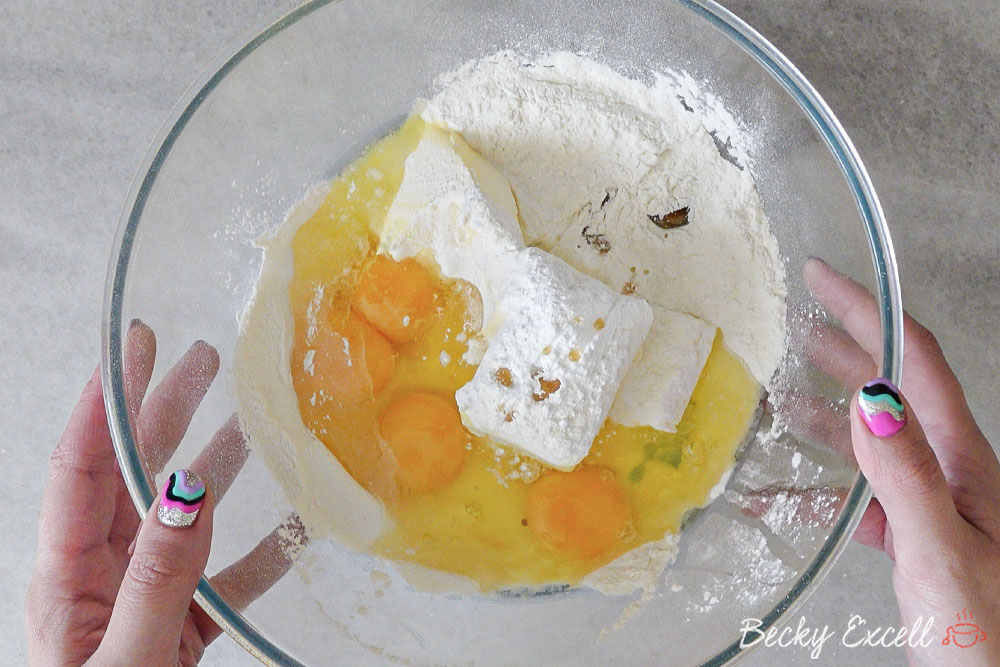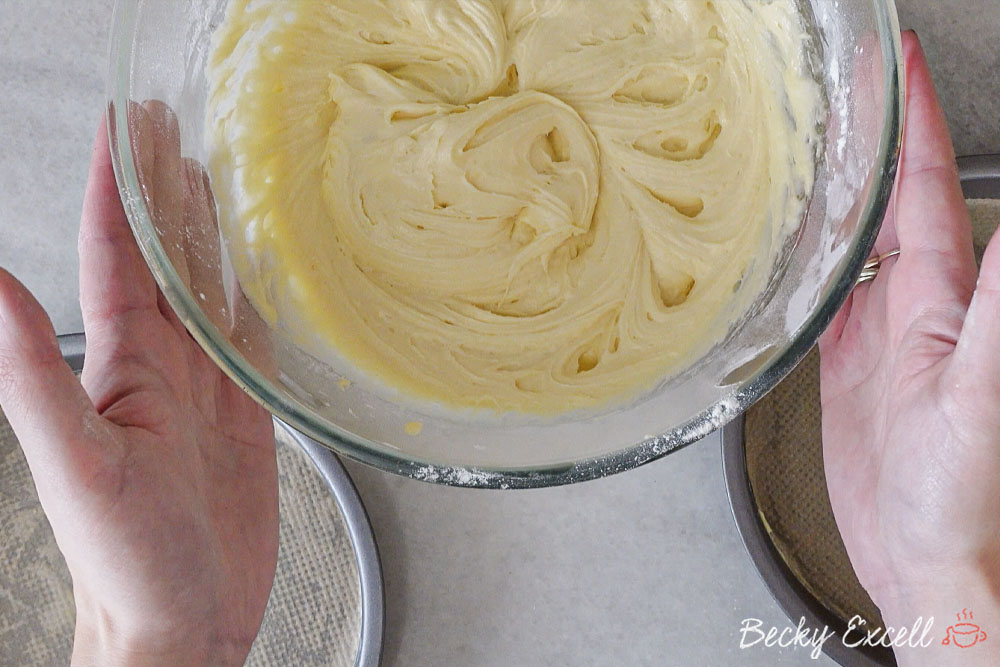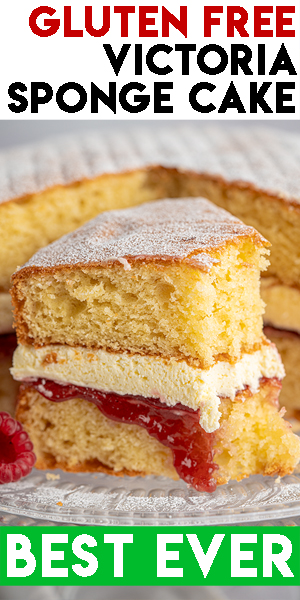Gluten-free Victoria sponge cake recipe – my BEST EVER recipe that nobody would ever know is gf! This post also includes a tutorial video on how to make it AND tons of step-by-step photos.
Gluten-free Victoria sponge cake recipe, anyone? It’s an absolute classic that you can use in so many different ways and it’s super easy to make using the all-in-one method.
When it comes to baking, you just absolutely can’t beat the simplicity of an all-time classic.
But that simplicity often leaves you little room to hide if your gluten-free sponge is dry, crumbly or has little rise. You can’t even slather this bake with icing to hide your shame!
And fortunately, with my gluten-free Victoria sponge cake recipe, you won’t even need to. Yep, this bake tastes EXACTLY like a Victoria sponge that contains gluten.
Best of all, this bake is so incredibly easy to nail – especially as I’ve included tons of step-by-step photos AND a recipe tutorial video in this post for you guys to follow.
Why bake my gluten-free Victoria sponge cake recipe?
- The sponge is super easy to make using the all-in-one method. Just bung it all in a bowl and mix!
- The sponge is golden, soft, light and moist – NOT crumbly or dry at all.
- This recipe includes the recipe for my ULTIMATE fluffy vanilla buttercream that holds perfectly when piped.
- You’d never know this recipe was gluten-free AT ALL – yes, even muggles will eat this, so watch out!
- This is one of the few recipes on the blog with a recipe tutorial video AND step-by-step photos. So you absolutely cannot go wrong here.
So, here’s the big question: what does my gluten-free Victoria sponge cake taste like?
Those golden, vanilla sponges are soft, light and fluffy, whilst staying lovely and moist. Not crumbly or dry AT ALL, with a lovely texture that even your muggle friends/family will enjoy.
Of course, you’ve got a layer of ruby red raspberry jam, topped with my BEST EVER vanilla buttercream. It’s packed with tons of vanilla flavour, it’s light and whippy and adds a lovely dimension of sweetness.
Sprinkle a little icing sugar on top and garnish with fresh raspberries if you fancy and enjoy whenever you like. So many of you guys have made this recipe into amazing birthday cakes, drip cakes and beautiful showstoppers, showing me it’s more versatile than I could have ever thought!
Here’s everything you’ll need for this recipe – consider this your shopping list!
Gluten-free Victoria sponge cake recipe: Ingredients
For the sponge
- gluten free self raising flour
- baking powder, (ensure it’s gluten free)
- xanthan gum
- margarine / spread / softened butter, (dairy free if necessary)
- caster sugar
- 4 eggs
- vanilla extract
For the butter cream icing
- icing sugar
- margarine / spread / butter , (dairy free if necessary)
- vanilla extract
You’ll also need…
- raspberry (or strawberry jam)
- fresh raspberries, (optional)
- icing sugar, (for dusting on top)
Looking for the measurements? Keep scrolling until you see the recipe card for the measurements and method…
So I thought I’d kick things off with a little frequently asked questions section – if you just want the recipe, then keep scrolling.
But I’ve thrown in some tips here that will be really helpful if this is your first time baking this, or you want to adapt it. So here they are!
Gluten-free Victoria sponge cake recipe: Frequently Asked Questions
Can I make this recipe gluten free? Is it suitable for Coeliacs?
It is gluten free, though nobody would know just by tasting it – trust me!
Bear in mind that minimising cross-contamination is hugely important if you’re Coeliac or making this for someone who is. Here’s some tips from Coeliac UK on minimising the risk of cross contamination:
Also, make sure that all ingredients used don’t have any gluten-containing ingredients. Then make that that they also don’t have a ‘may contain’ warning for gluten, wheat, rye, barley, oats (which aren’t gf), spelt and khorasan wheat (aka Kamut).
Here’s some more info from Coeliac UK on identifying safe gluten free products.
Can I make your gluten-free Victoria sponge cake recipe dairy free?
Yep – you can easily make this dairy-free with a couple of simple swaps.
- For the sponge cakes, all you need to use is a softened block of hard margarine or a dairy free margarine spread like this, instead of butter.
- Whilst you can use a dairy free margarine spread for the cake, DO NOT use it for the buttercream. It’s far too soft and won’t hold like buttercream should. Use the hard block of margarine instead for that – you may need to add a little more icing sugar to bring it together as hard margarine is softer than butter.
Can I make your gluten-free Victoria sponge cake recipe vegan?
Yep! If you follow the instructions above to make this recipe dairy free, then all you’ve got left to contend with is the eggs.
Whilst I haven’t specifically labelled this recipe as being vegan-friendly because 4 eggs is quite a few to replace and results can vary, you’re welcome to try some of these egg replacements listed below.
Here’s a few ideas you can use as egg replacements, so each of these = 1 egg.
- 3 tablespoons of aquafaba – water from a can of chickpeas. Keep the chickpeas for a future dinner!
- 1 tbsp of ground flaxseed and 3 tbsp of water
- Egg replacement powder – I’d recommend using Orgran as it’s gluten free.
- 1 tablespoon of chia/flax seeds mixed with 2 tablespoons of water and left for 10 minutes in the fridge.
- 3 tablespoons of applesauce.
I haven’t tested all of these egg alternatives so let me know how you get on in the comments below.
Can I make this recipe low FODMAP?
Yes! One slice of this cake is low FODMAP and suitable for the elimination phase of the diet.
Is your gluten-free Victoria sponge cake recipe nut free?
Yep, this is a nut-free recipe as far as ingredients go, BUT make sure you check the ingredients label on ALL the products you use to bake this cake just to be safe.
Even if the products don’t contain nuts, they may have a ‘may contain nuts’ warning due to being produced in a factory that handles nuts.
You can never be too careful so always read the labels on everything first.
Can I make this using the creaming method?
Of course – I prefer to use the all-in-one method for these as I find it’s always a safe bet with a simple sponge like this.
But of course, you’re more than welcome to cream the sugar and softened butter together, then add the eggs and mix, THEN add the flour and mix once more.
It works perfect both ways so it’s totally up to you!
Can I make your gluten-free Victoria sponge cake in a food processor or standing mixer?
Of course you can, but you definitely don’t need to. I use both a stand mixer and an electric whisk for this recipe. Here’s a link to the electric whisk I use.
For the buttercream, I always prefer to make it in my stand mixer, purely because of the amount of mixing it takes to beat the butter until it becomes pale. But you can always use an electric whisk for this too.
You can of course, use either for both tasks too, just make sure you clean your stand mixer bowl in between of course.
Can I make your gluten-free Victoria sponge cake recipe by hand?
You can of course, bake this without any assistance from any appliance – just a good ol’ fashioned silicone spatula will do. Just make sure you give it a lot of welly, otherwise your mixture won’t be consistent and might not bake properly.
Making the buttercream by hand is definitely possible, but it’ll take longer and requires a little more effort. But it’s doable!
Do I need any special equipment to bake your gluten-free Victoria sponge cake?
Certainly not! You will need a good quality baking tin (I used 2) so here’s a link to the one I use.
I’d always recommend having two tins so you can bake both sponges at the same time. If you bake them one at a time, the second sponge won’t rise as much as the first.
Does this recipe need xanthan gum?
In some of my recipes, yes, but I wouldn’t recommend leaving xanthan gum out of this one. You’ll see xanthan gum in a lot of my recipes as it’s an essential ingredient in gluten-free baking.
Without gluten to bind the cake batter together, you can be left with a very loose and crumbly sponge texture which won’t work for this recipe.
Some people have asked if they can use psyllium husk powder instead of xanthan gum, but I’ve found that it definitely results in a denser sponge so I wouldn’t overly recommend it.
If you’re really against xanthan gum or you simply don’t have any, you can omit it if pushed. There’s a little in gluten-free self-raising flour anyway, so it should still turn out fine.
Can I make this recipe using other gluten free flours like buckwheat flour or coconut flour?
There’s a big difference between ‘gluten free plain/self-raising flour’ and a *singular* type gluten free flour. When I say ‘gluten free plain or self-raising flour’ in a recipe, I mean a BLEND of gluten free flours, not just one, singular flour.
Most gluten free flour you buy in the supermarket typically contains a blend of rice flour, potato flour, maize flour, tapioca flour AND buckwheat flour. That’s a lot of different flours!
So to replace it with just one specific type of flour… that’s not going to cut it at all. Definitely go for a gluten free flour blend.
Do I need weighing scales to bake your gluten-free Victoria sponge cake?
In short… yes, yes and yes! And I wouldn’t advise attempting any my recipes without them.
A lot of work went into fine tuning ratios and quantities and for me, baking is all about consistency and precision. I want you to make this recipe and for it to turn out EXACTLY like mine did.
I’d recommending using digital cooking scales like these so you know you’re getting an accurate measurement and replicating my recipe as accurately as poss.
Can I bake your gluten-free Victoria sponge cake with less sugar / without sugar?
I can definitely understand the need to reduce sugar in our foods, but this is one of the recipes where I wouldn’t advise it.
Of course, the sugar isn’t just for sweetness – it’s integral to the structure of the cake once baked and is super important.
The more you reduce the sugar in the sponge, the more dry and ‘mealy’ the cake will become.
You can of course reduce the buttercream if you’re concerned about sugar – it’s up to you.
How long can I keep your gluten-free Victoria sponge cake for?
I’ve kept it for about 4-5 days in an air-tight container with no problems. If you need it any longer than that, I’d highly recommend freezing it (see advice below for doing that)
When the cake starts getting a little dry, it’s probably starting to get past its best.
Can I freeze your gluten-free Victoria sponge cake?
Of course! I’ve frozen it for up to 2-3 months no problem. Ideally, slice up the cake first before freezing – that way you can simply defrost slices as and when you need them.
Plus, it’ll thaw a lot quicker. When you want to eat it, each slice should take around 4 hours to defrost at room temperature.
How can I tell when my gluten-free Victoria sponge cake is done?
Grab a skewer and give it a poke in the centre. If it comes out clean, then it’s done!
But if the skewer comes out moist and cake-like, it’s best to pop it back in for a bit longer.
Gluten-free Victoria sponge cake recipe: Method
Prepare 2 circular cake tins (mine are 20cm) – grease them and cut a circle of parchment paper to sit in the bottom. Preheat your oven to 160C Fan.
Place all your sponge ingredients into a large mixing bowl and whisk until well combined and thoroughly mixed (1 minute should do it).
Divide the mixture between the two tins evenly.
Bake for around 30 minutes until golden (remember never to open the oven until you think they are definitely done). To check if the sponges are cooked, insert a skewer and if it comes out clean, it’s done!
Leave the sponges in their tins for about 5 minutes before turning them out onto a cooling rack.
Whilst the sponges are cooling, make your buttercream. Start by adding your margarine / spread / butter to a bowl and cream it together. This can be done by hand or with an electric hand whisk.
Once creamed, gradually add your icing sugar – it seems like a lot but it will all incorporate itself.
Add your vanilla extract and mix once more.
To decorate, spread jam on the bottom layer of the cake. If you want to pipe your buttercream, place it in a piping bag and pipe a dollop followed by a raspberry and continue this around the edge. Then in the centre, just pipe lots of extra dollops of buttercream. Place your second sponge on top.
If you don’t want to pipe your buttercream, spread your buttercream on one of your sponges, jam on the other and sandwich them together (you can also add fresh raspberries on top of the cake if you want).
Dust with a little icing sugar on top. Enjoy!
Oh and here’s a printable version of my gluten-free Victoria sponge cake recipe. Please remember to give it 5 stars if you tried it and enjoyed it as it helps people know it’s worth trying too! ⭐️

Gluten-free Victoria Sponge Cake Recipe - BEST EVER! (low FODMAP, dairy-free option)
Ingredients
For the sponge
- 225 g gluten free self raising flour
- 1 tsp baking powder (ensure it's gluten free)
- 1/4 tsp xanthan gum
- 225 g margarine / spread / softened butter (dairy free if necessary)
- 225 g caster sugar
- 4 eggs
- 1 tsp vanilla extract
For the butter cream icing
- 500 g icing sugar
- 250 g margarine / spread / butter (dairy free if necessary)
- 1 tsp vanilla extract
You'll also need...
- raspberry or strawberry jam
- fresh raspberries (optional)
- icing sugar (for dusting on top)
Instructions
- Prepare 2 circular cake tins (mine are 20cm) - grease them and cut a circle of parchment paper to sit in the bottom. Preheat your oven to 160C Fan.
- Place all your sponge ingredients into a large mixing bowl and whisk until well combined and thoroughly mixed (1 minute should do it).
- Divide the mixture between the two tins evenly.
- Bake for around 30 minutes until golden (remember never to open the oven until you think they are definitely done). To check if the sponges are cooked, insert a skewer and if it comes out clean, it's done!
- Leave the sponges in their tins for about 5 minutes before turning them out onto a cooling rack.
- Whilst the sponges are cooling, make your buttercream. Start by adding your margarine / spread / butter to a bowl and cream it together. This can be done by hand or with an electric hand whisk.
- Once creamed, gradually add your icing sugar - it seems like a lot but it will all incorporate itself.
- Add your vanilla extract and mix once more.
- To decorate, spread jam on the bottom layer of the cake. If you want to pipe your buttercream, place it in a piping bag and pipe a dollop followed by a raspberry and continue this around the edge. Then in the centre, just pipe lots of extra dollops of buttercream. Place your second sponge on top.
- If you don't want to pipe your buttercream, spread your buttercream on one of your sponges, jam on the other and sandwich them together (you can also add fresh raspberries on top of the cake if you want).
- Dust with a little icing sugar on top. Enjoy!
Nutrition
Any questions about the recipe? Please do let me know by following me on Instagram and leaving me a comment on a recent photo!
Thanks for reading,
Becky xxx
Oh and don’t forget to pin this for later!



















